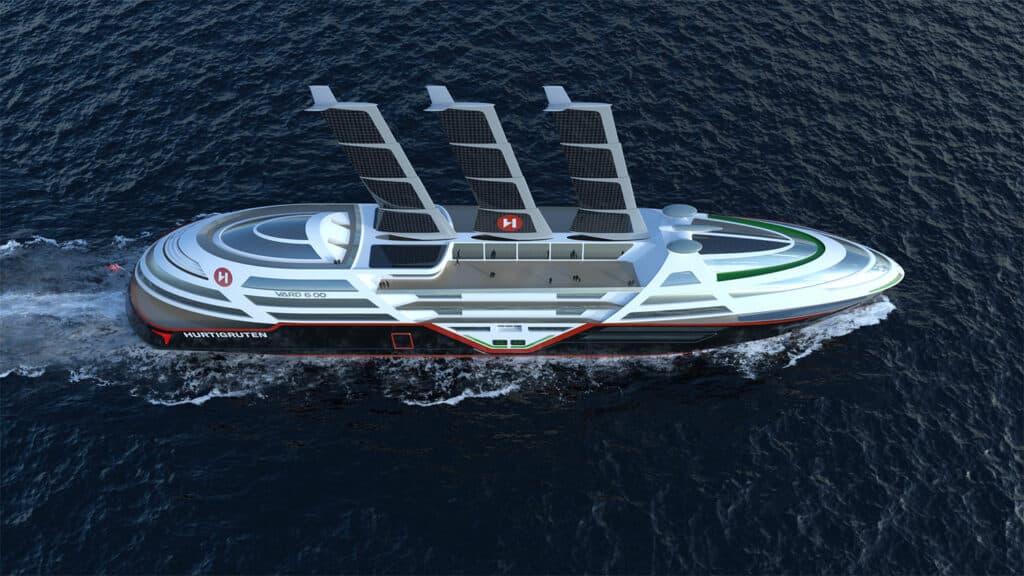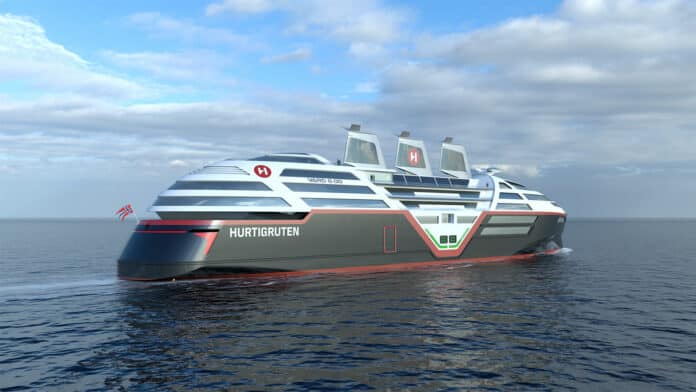Oslo-based cruise and ferry company Hurtigruten Norway has unveiled plans for its first zero-emission ship weeks before its 130th anniversary. Under the project name ‘Sea Zero,’ the first-of-its-kind initiative has revealed early concept plans for the world’s most energy-efficient cruise ship.
Cruise ship pollution is a major part of our environmental impact. To reduce this impact, Hurtigruten is looking to develop a sustainable zero-emission cruise ship to operate along the Norwegian coast by 2030. The company then plans to transform its entire fleet into eco-friendly electric liners.
The Sea Zero project was first launched in March 2022. Hurtigruten teamed up with 12 maritime partners and the research institute SINTEF to achieve emission-free marine travel. Hurtigruten Norway’s project aims to drastically improve the greater cruise industry’s sustainability record and the future of travel.
The new zero-emission ship is modeled at 135 meters (443 feet) long and will feature 270 cabins for up to 500 guests and cabins for 99 crew. The new ship will also have a significant cargo hold and transport cars.

The vessel is expected to feature numerous firsts and improved solutions that do not exist on cruise ships today, including retractable sails with solar panels, artificial intelligence maneuvering, contra-rotating propellers, and multiple retractable thrusters. Additional technologies include air lubrication, advanced hull coating, and proactive hull cleaning.
In terms of power, the Sea Zero cruise ship will be equipped with a 60 MWh battery pack that can be charged in port. The three retractable, autonomous wing rigs will comprise 1500m2 (16,146 ft2) of solar panels and a total wind surface of 750m2 (8,073 ft2), reaching a maximum height of 50m (164 ft) when fully extended. The setup will generate additional green energy from the sun and extra grunt from the wind.
The company strives for superior guest comfort and spectacular views on board its first zero-emission ship. A streamlined shape will result in less air resistance, reduce energy use, and increase passenger comfort. In addition to ample outdoor space, enlarged surface areas with dedicated windows will allow for unparalleled views of what is often described as ‘the world’s most beautiful coastline.’
Guests will play a key role in minimizing energy consumption through an interactive mobile app, where they can operate ultra-modern cabin ventilation as well as measure their own water and energy consumption.
“When we initially announced the ‘Sea Zero’ project over a year ago, we were faced with the challenge of not knowing which technologies would be available to us in 2030. Our task was to pave the way for new innovations and enhance existing ones to align with our sustainability objectives. While some of these technologies have reached a relatively advanced stage, they still necessitate dedicated research and development to ensure successful implementation within the maritime context. On the other hand, certain technologies are still in early development and require fundamental research and thorough testing. Following a rigorous feasibility study, we have pinpointed the most promising technologies for our groundbreaking future cruise ships. We are committed to delivering a ship that surpasses all others in terms of energy efficiency and sustainability within just a few years,” said Hedda Felin, the CEO of Hurtigruten Norway.
Sea Zero has now entered a two-year phase in which the proposed technologies will be tried, tested, and developed further in pursuit of the final zero-emission ship.
